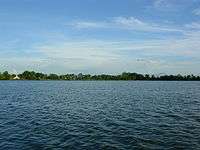Sukhrungphaa
| ||||||||||||||||||||||||||||||||||||||||||||||||||||||||||||||||||||||||||||||||||||||||||||||||||||||||||||||||||||||||||||||||||||||||||
Sukhrungphaa (reignreign 1696–1714), or SwargadeoSwargadeo Rudra Singha (Assamese: স্বৰ্গদেউ ৰূদ্ৰ সিংহ), was a Tungkhungia king of the Ahom kingdom under whom the kingdom reached its zenith of power and glory. Rudra Singha, known as Lai before he became the king, was the son of the previous Ahom king Gadadhar Singha. An illiterate (probably dyslexic), he is best known for building a coalition of rulers in the region and raising a vast composite army against the Mughal Empire. He died on the eve of his march west from Guwahati.
His father had to escape persecution by the previous Ahom king and his mother, Joymoti Konwari, was killed in royal custody. He established his capital at Rangpur.
Reign
Political works
Though he was an illiterate himself, he had an expansive and progressive political vision, just as Akbar had. Rudra Singha subjugated the Dimasa (1706) and the Jaintia kingdoms. His father had removed the last vestiges of the Mughal rule in Assam, and he planned to extend his kingdom up to the Karatoya River, the traditional western boundary of the erstwhile Kamarupa kingdom. He began forming an alliance with different kingdoms and positioned himself at Guwahati for the expedition with a large army and fleet, along with the troops from the Dimasa-Kacharis (14,000), the Jaintiyas (10,000) and the Daflas (600), when he died. The later kings did not follow up on his plans.
Rudra Singha reversed the persecution of the Vaishnava xatras during Gadadhar Singha's reign and reinstated the xatra preceptors, including Chaturbhujdeva the satradhikari of Mayamara xatra, in their former seats.[1] But he forbade the sudra satradhikars from initiating Brahmins and Brahmins from vising sudra monasteries, under the influence of the gosain of Auniati xatra who was the royal perceptor.[2]
Administrative works
He encouraged exchanges with other kingdoms and sent ambassadors to other royal houses in various parts of India. He created khels or official positions specifically for diplomacy, like Khaund, Kotoki, Bairagi, Doloi, Kakoti. He sent men to Delhi to learn music and Brahman boys to Gurukuls for Vedic and Sanskrit studies. He brought architects from outside for constructing the palace and other buildings in the new capital city, Rangpur. He introduced Mughal style dresses in the Ahom court. He encouraged the culture of local folk music and dance and appointed officers called Gayan Baruas. It is said that he was the first Ahom king to have the Bihu celebrated in the courtyard of the palace and gave royal patronage to Bihu.
As he grew older, he felt more and more drawn towards Saktism and decided to become a sakta. However, he died before his initiation could be completed. He instructed his sons to invite the Bengali priest Krishna Ram Bhattacharyya and accept him as their religious guide.

Civil works
- In honour of the memory of his mother Joymoti Konwari, he dug the Joysagar Tank, India's largest man-made tank covering an area of 318 acres (1.29 km2), including its four banks. * In 1703, he built the Ranganath (Shiva) Temple near the Borduar, or main gateway, on the way from the Joysagar Tank to the Talatal Ghar - for the offering of prayers to Shiva.
- Before the Ranganath Dol, a pyramid-shaped temple was constructed in 1703–04, to perpetuate the memory of his mother Joymoti Konwari: this marked the "Maidam" of Joymoti. * * Numerous other architectural monuments and structures are credited to him, including the Namdang stone bridge of Gaurisagar, and the Kharikatia Ali (ali meaning road in Assamese) - leading from Kharikatia to Titabor. The Namdang bridge, a stone bridge 60m long, 6.5m wide, and 1.7m thick was built over the Namdang River in 1703. It is one of the best examples of the engineering workmanship and skill of the Ahom era. This bridge, on National Highway no.37, has been proudly providing service for the last 300 years.
See also
- Ahom Dynasty
- Ahom History
Notes
References
- Baruah, S L (1993), Last Days of Ahom Monarchy: A History from 1769 to 1826, Munshiram Manoharlal Publishers Pvt Ltd, New Delhi.
- Gait, Sir Edward (1905), A History of Assam, LBS First Edition, 1983, LBS Publications, Guwahati.

